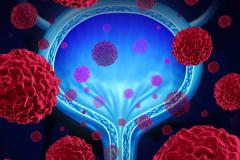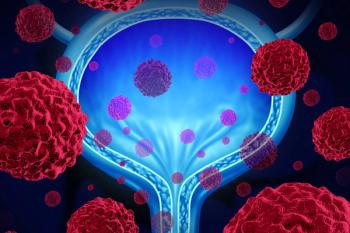
Patient Case Review: What is a Typical Presentation of Bladder Cancer?
Expert panelists review a patient presentation of bladder cancer and consider the typical signs and symptoms that may lead to a diagnosis.
Episodes in this series

Transcript:
Petros Grivas, MD, PhD: Hello, and welcome to this CancerNetwork® presentation entitled, “Morning Rounds: The Bladder Cancer Treatment Paradigm.” I’m Dr Petros Grivas, your host for today. I’m a medical oncologist in Seattle, a professor in oncology, and the clinical director of the genitourinary [GU] cancers program at the Fred Hutchinson Cancer Center and the University of Washington [in Seattle]. I’m very excited and thrilled to be joined today by 3 amazing providers and members of our team. I will let each of them introduce themselves. Let’s start with Dr Emily Weg. Emily?
Emily S. Weg, MD: Good morning, it’s a pleasure to be with you today. I’m Emily Weg, I’m an assistant professor in the department of radiation oncology at the University of Washington and the Fred Hutchinson Cancer Center, and I specialize in genitourinary malignancies.
Petros Grivas, MD, PhD: Great, Emily. And it’s great to work with you on our team. Then we have Lisa Adams, who’s a fantastic physician assistant in Colorado. Lisa?
Lisa Adams, PA-C: Hi, I am Lisa Adams. I’m a physician assistant in a medical oncology practice with the University of Colorado Health System [in Colorado Springs]. I’m very excited to be here this morning.
Petros Grivas, MD, PhD: Welcome, Lisa. [It’s] great to have you. Talking about fantastic physician assistants, I’m also thrilled to be joined by Nerina McDonald. She’s also a physician assistant, and she’s working with us here at the University of Washington and Fred Hutch. Nerina?
Nerina T. McDonald, PA-C: Hi, I’m Nerina McDonald, I’ve been practicing in GU oncology at Fred Hutchinson Cancer Center for about 4 years now, and I have the pleasure of working with Dr Grivas on a regular basis in our clinic.
Petros Grivas, MD, PhD: Thanks, Nerina. It’s a pleasure to do this together today. We’re going to discuss the testing and treatment of patients with metastatic bladder cancer and urothelial cancer in general. Of course, the field is evolving so rapidly, and it’s really exciting to see the advances in the field. We’re going to look at some clinical scenarios and review best practices, and I want to hear and learn from my colleagues here today. Let’s begin, starting with a case, to put things in context. Again, as I mentioned before, it’s a great opportunity to do this program because so much has been changing in the field of urothelial cancer.
This particular case we have today is an 80-year-old gentleman who presents to the emergency department reporting severe lower abdominal pain in the suprapubic area, fatigue, tiredness, as well as increased urinary frequency and urgency. [He has] also noticed hematuria, blood in the urine, over the past few days. This gentleman has a history of smoking, he’s a former smoker with a 20 pack-year history. He quit about 10 years ago. His medical history is also significant for mild COPD [chronic obstructive pulmonary disease] and diabetes mellitus, which is controlled by medications. I know this is not the most common scenario of presentation of bladder cancer. Most of the patients come to us through urology, hematuria and other urinary tract symptoms, is the main entrance point for patients. Emily, I’ll start with you, you’re a very accomplished radiation oncologist. Do you get calls sometimes from the emergency department for newly diagnosed, newly presented patients? It’s probably less common, right?
Emily S. Weg, MD: Yes, it’s pretty unusual that the emergency department would call the radiation oncologist. But I think a lot of this patient’s presentation is fairly typical. About 75% of patients with bladder cancer present with hematuria, and about a quarter of them present with lower urinary tract symptoms, like frequency, urgency, and discomfort with voiding. The suprapubic pain you described and the dramatic nature of this presentation is a bit unusual. The way radiation oncology is usually roped into the picture is, traditionally, once there’s already a proven tissue diagnosis.
Petros Grivas, MD, PhD: Thank you, Emily, I totally agree with you. And I think even in our practice, Nerina, you probably would agree that the vast majority of our patients come through the urology practice. It’s not that common to get this presentation, but it can happen. Sometimes we have a de novo metastatic urothelial cancer. Just for context for the audience, if you have 100 patients diagnosed with bladder cancer de novo, only about 4% or 5%, as Dr Weg mentioned, present de novo with metastatic disease. Usually, it’s already been diagnosed in early stage disease. I will ask you, Nerina, when we meet those patients in the clinic, could you comment a bit about the symptoms they have, especially with metastatic disease? What are they complaining about? What are their symptoms?
Nerina T. McDonald, PA-C: I think patients may often present with urinary obstruction, irritated voiding, and pain. If they are in a metastatic setting, I have seen a handful of patients who are having bone pain due to bone metastases. Sometimes we can see constitutional symptoms, such as fatigue, weight loss, anorexia, failure to thrive, etc.
Petros Grivas, MD, PhD: [I] totally agree with you, and it depends on the [type of] disease and the extent of the disease. Lisa, I know sometimes there might be some differences between community practices and academic practices, mostly because the patients may start in a community practice, which may be closer to home for them. I talk frequently with my colleagues in community practices, and the patients we see sometimes in the tertiary academic center may be a bit filtered, selective populations who travel to see us. [Do you have] any comments on your end about the initial presentation of patients through the clinic, or the emergency department?
Lisa Adams, PA-C: Absolutely. Where we are in southern Colorado, we do serve a larger rural population, where maybe access to primary care, screening, and early referrals to specialists may be a bit less. So we do see maybe a bit more of this similar presentation of patients diagnosed in the advanced setting, or maybe going to the emergency department rather than through the traditional routes.
Petros Grivas, MD, PhD: [I] totally agree. Access to primary care, of course, and access to care in general I think is key and is not always given. That brings up an important point, Lisa, about disparities in health care, and how can we go work altogether, different stakeholders, to eliminate those disparities and provide access to care, diagnostic work-up. There are many initiatives, especially with the Bladder Cancer Advocacy Network, BCAN, that try to spread the word to people who have symptoms like blood in the urine, or other urinary tract symptoms, to seek medical attention early, and be referred to a urologist for work-up. It’s a very important need. And of course, as a medical oncologist or radiation oncologist in this group today, we usually see the patients after the diagnosis is made. The urologist is usually the first point of contact. Less commonly, in a situation like this when a patient goes to the emergency department, depending on the setting, maybe a biopsy of a metastatic site may be needed, or cystoscopy, and tumor tissue acquisition through a cystoscopy through a urologist.
Transcript edited for clarity.
Newsletter
Stay up to date on recent advances in the multidisciplinary approach to cancer.



















































































